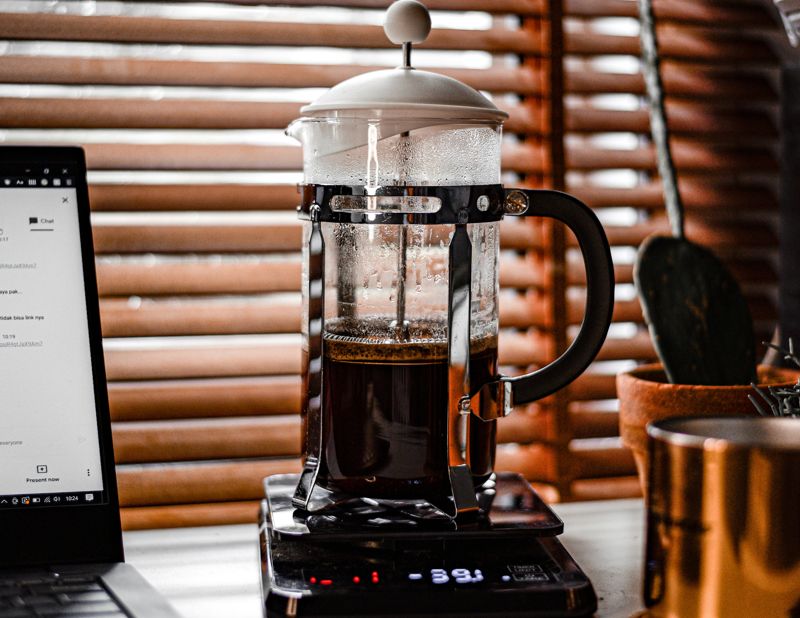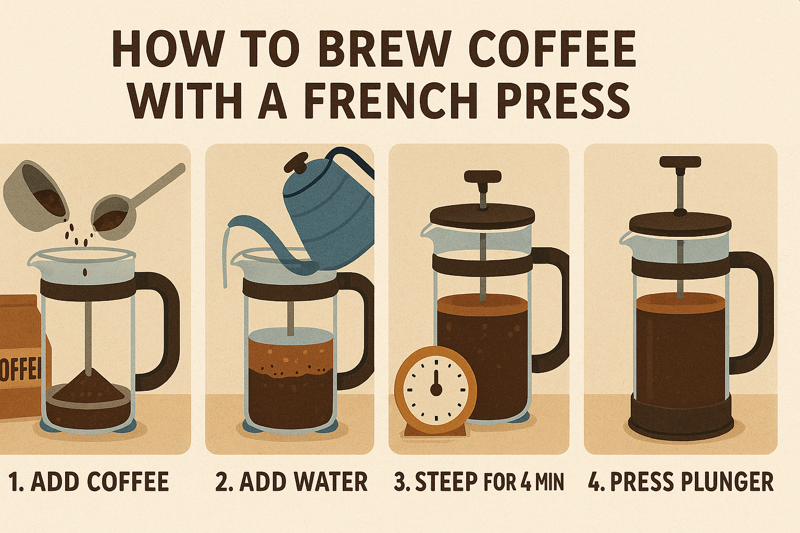
Many coffee lovers enjoy the ritual of brewing coffee in their kitchen at home. Among the different methods, the French press remains one of the simplest and most rewarding.
It needs no complicated gear, no paper filters, and no fuss. Just hot water, coarsely ground beans, and a little patience. The result is a rich, full-bodied drink that highlights the natural character of the beans.
Choosing the Right Press
When it comes to selecting a press, you will find a variety of options. Glass and stainless steel French presses are the most common. Glass ones let you see the brewing process, while steel models hold heat for longer.
Both types can give you an excellent cup, so the choice depends on whether you value style or insulation. Whichever you pick, make sure the plunger fits snugly, as a loose filter can let too many grounds slip through.
Picking the Coffee
The quality of your drink starts with the beans. Choose whole beans rather than pre-ground, as they keep their flavour better. Go for a medium to dark roast if you prefer a stronger, bolder taste. A lighter roast will bring out brighter, fruitier notes. For the French press, always grind coarsely. A fine grind clogs the filter and makes the brew muddy. A burr grinder works best for even results.
One detail that often goes unnoticed is the freshness of the beans. Coffee begins to lose its aroma and vibrancy within weeks of roasting, so try to buy from a local roaster and use your beans within a month of their roast date. Storing them properly also makes a difference—keep them in an airtight container, away from light and moisture, but avoid the fridge, as it introduces unwanted humidity. Fresh beans, ground just before brewing, are the single most effective way to elevate your French press coffee.
Measuring the Ratio
Getting the right balance between coffee and water is key. A good starting point is one tablespoon of ground coffee for every 120 millilitres of water. You can adjust this ratio to suit your taste.
Too much coffee will make the drink bitter. Too little will leave it weak and flat. Once you find the right balance, stick to it for consistent flavour.
Heating the Water
Water temperature is often overlooked, but it makes a big difference. Boiling water can scorch the grounds, while water that is too cool will not extract enough flavour. Aim for around 93–96°C, which is just off the boil.
If you don’t have a thermometer, let freshly boiled water sit for about thirty seconds before pouring it over the grounds.
Brewing the Coffee

To brew, place the ground coffee into the press. Pour in half the water first, giving it a gentle stir to wet all the grounds. This stage, called “blooming,” allows gases to escape and helps with even extraction. After about thirty seconds, add the rest of the water. Place the lid on, but do not press the plunger yet. Let the coffee steep for about four minutes. You can experiment with a little more or less time depending on how strong you like it.
Some enthusiasts also experiment with stirring at different stages. A gentle swirl after adding all the water can encourage even extraction, while leaving the brew untouched creates a thicker layer of grounds on top that helps trap heat. Neither approach is “right” or “wrong”—it simply depends on the style of coffee you enjoy. The beauty of the French press is that it gives you control and flexibility to adapt the process to your preferences.
Pressing and Pouring
When the time is up, slowly push the plunger down. Apply steady pressure rather than forcing it. A smooth press keeps the grounds at the bottom and leaves you with a clean brew. Once pressed, pour the coffee right away.
Leaving it in the pot will cause it to over-extract and taste bitter. If you have extra, transfer it to a carafe or flask to keep it warm without spoiling the flavour.
Enjoying the Result
French press coffee has a unique texture. It feels heavier on the tongue than filter coffee and carries more of the natural oils. Some people enjoy it black, while others add milk or cream. However you prefer it, take the time to notice the aroma and flavour notes. That’s what makes this method special—it captures more of the bean’s true character.
If you want to refine your palate, try brewing the same beans in different ways—French press, pour-over, or espresso—and compare the results. You will start to notice how the method influences body, clarity, and flavour balance. Over time, this practice not only makes you a better brewer but also deepens your appreciation for the complexity of coffee. The French press stands out because it highlights richness and mouthfeel, making it a favourite for those who value depth over sharpness.
The French press is proof that making good coffee doesn’t need to be complicated. With the right beans, the proper grind, and careful attention to timing, you can enjoy a café-quality drink at home. Once you master the basics, you may find that the ritual itself becomes as satisfying as the coffee in your cup.
